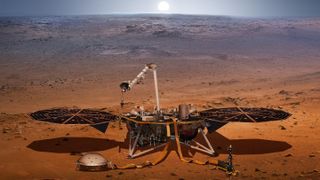Massive earthquake that shook Mars is 5 times stronger than any other
With death closing in, NASA's Mars InSight Lander picked up a record-breaking Marsquake in May.

NASA's InSight Mars Lander has detected a marsquake at least five times as large as the next largest ever recorded on the Red Planet. It had a magnitude of 4.7, lasted more than four hours and was unlike any of the thousands of Marsquakes previously detected. The previous biggest Marsquake, detected in August 2021, had a magnitude of 4.2.
Labeled S1222a, the Marsquake on May 4, 2022, occurred in an unexpected region of Mars outside the tectonically active Cerberus Fossae region. The quake sent seismic surface waves entirely around the planet's circumference — the first time that had ever been seen on Mars. These seismic waves revealed layers of sedimentary and volcanic rock in the Red Planet's crust that could indicate a past collision with a massive object, such as a meteoroid or comet, according to a study published Dec. 14 in the journal Geophysical Research Letters.
"The energy released by this single marsquake is equivalent to the cumulative energy from all other Marsquakes we've seen so far, and although the event was over 1,200 miles [1,931 kilometers] distant, the waves recorded at InSight were so large they almost saturated our seismometer," John Clinton, study co-author and seismologist at the Swiss Federal Institute of Technology in Zürich, said in a statement.
InSight is a stationary platform on Mars. It was launched in May 2018, landing in the Elysium Planitia region in November 2018. It's equipped with a seismometer to study the crust, mantle and core of the Red Planet. So far it's discovered that the planet's Cerberus Fossae region to the rover's northeast is the most tectonically active. However, S1222a occurred 37 degrees southeast of InSight.
"The seismometer aboard the InSight lander has recorded thousands of marsquakes but never one this large, and it took over three years after landing to record it," study author Caroline Beghein, a professor in UCLA's department of Earth, Planetary and Space Sciences, said in a statement. "This quake generated different kinds of waves, including two types of waves trapped near the surface."
The waves from the quake lasted about 10 hours, ten times longer than previously detected.
Sign up for the Live Science daily newsletter now
Get the world’s most fascinating discoveries delivered straight to your inbox.
Only one of the two types of wave has been observed on Mars before and, crucially, only after a meteorite strike, never during a marsquake.
This landmark discovery is likely to be one of Insight's last. Dust storms have gradually covered the platform's solar panels, reducing its power to critical levels. It's not expected to last much beyond the end of 2022, scientists predict..
"We are impressed that almost at the end of the extended mission, we had this very remarkable event," said lead study author Taichi Kawamura, a planetary scientist at the Institut de physique du globe de Paris, France. "This mission was an extraordinary success.
Jamie Carter is a freelance journalist and regular Live Science contributor based in Cardiff, U.K. He is the author of A Stargazing Program For Beginners and lectures on astronomy and the natural world. Jamie regularly writes for Space.com, TechRadar.com, Forbes Science, BBC Wildlife magazine and Scientific American, and many others. He edits WhenIsTheNextEclipse.com.
Most Popular

